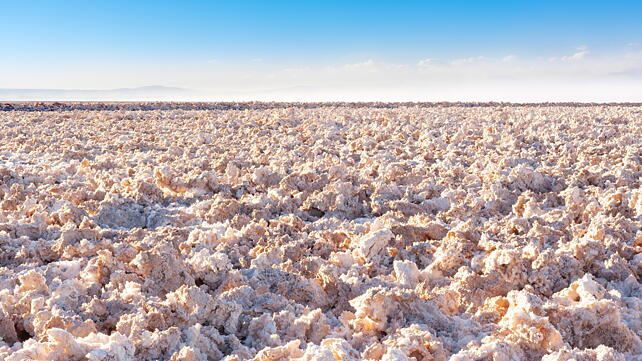
(With inputs from Amrita Shetty)
The recent discovery of a deposit of nearly 5.9 million tons of lithium inferred resources by the Geological Survey of India (GSI) could be just the catalyst India needs to accelerate its green energy programme.
Preliminary exploration has uncovered the presence of this geologically rare resource in the Reasi district of Jammu & Kashmir. This is a promising development at a time when demand for lithium is skyrocketing. However, it is worth noting that two more stages will be required to determine whether it can be viably extracted for commercial use.
Lithium is seen as a critical resource in the transition to green energy alternatives. It is used in lithium-ion batteries for electric vehicles (EVs) by the automotive industry, in smartphones and laptops by the consumer electronics industry, and also finds use in solar panels and as part of a renewables-based, energy grid.
The volume of the deposits is substantial and will pitchfork India into the select league of countries that have reserves of these rare, crucial minerals. These include Chile, Bolivia, and Argentina that form the “lithium triangle” in Latin America and account for over three quarters of existing lithium reserves in Australia, China, and the US.
The finding is crucial for India from multiple counts with implications that stretch beyond the country. Today, demand for metals like lithium, nickel and cobalt is outstripping production. Global demand for lithium-ion batteries is set to surge five-fold by the end of the decade, with India completely dependent on countries like Argentina and Australia to meet its lithium supply needs and on China to meet its lithium-ion cell requirements.
Intensifying Demand-Supply Mismatch
Close to two billion EVs will be required if the International Energy Agency’s (IEA) goal of net zero by 2050 is to be realised. On the one hand, global EV sales are soaring: globally, they doubled over 2021-2022, while India registered a 210% year-on-year increase over the same time frame. At COP 26, 30 countries committed to halting sales of conventional fuel powered cars by 2040. And while production has been rising, it still falls well short of requirements.
Technology is the new battleground for supremacy, where critical minerals like lithium, nickel and cobalt are the ammunition. The need to build robust and reliable supply chains for such critical resources is, therefore, becoming a key element of national security and energy security agendas.

China currently accounts for around 60% of lithium chemical production and more than 75% of global lithium-ion battery manufacturing capacity. Five Chinese companies count among the top 10 lithium-ion battery manufacturers worldwide. In essence, therefore, China has a stranglehold over the supply chain for lithium-ion and EVs.
Meanwhile, the Indian government has set ambitious targets for vehicle electrification. It plans for EVs to comprise 30% of private cars, 70% of commercial vehicles, and 80% of two- and three-wheelers by 2030. The identification and potentially successful commercialisation of lithium deposits could fast-track the realisation of such a roadmap.
Energy security is a priority for countries the world over. In India’s case, China currently fulfils around 70% of the country’s lithium-ion cell requirements. With the identification of lithium reserves in India, import dependence is likely to be reduced, while providing a shot in the arm to domestic battery production.
Moreover, self-sufficiency in lithium production will limit exposure to supply chain volatility, support a steady raw material pipeline, and enable more cost-competitive domestic battery and cell production.
For the country’s automotive industry, it will provide a boost to ‘Aatmanirbhar Bharat’, spur domestic EV production, and allow stakeholders to more fully benefit from the production linked incentive (PLI) scheme.
Environmental Challenges Need To Be Addressed
This is not to say that the Jammu & Kashmir lithium reserve will be the magic pill. Although touted to be of “best quality”, it remains to be seen whether the resource can be extracted at scale for commercial use.
Environmental impacts present another challenge. The reserves are found in the ecologically sensitive Himalayan belt, which has been racked by earthquakes, land subsidence, and floods. Red flags are already being raised about lax environmental regulations and the general disregard for environmentally friendly mining practices.
High levels of water stress and carbon emissions – Chile’s lithium mining involves the use of 500,000 gallons of water to produce one ton of lithium and the open pit mining technique likely to be deployed in Reasi will typically result in 15 tons of carbon emissions for every one ton of lithium produced – also raise major question marks about the cost of transitioning to “green” energy.
While on the one hand, such mines offer the prospect of generating primary, secondary and tertiary employment, they also threaten to affect local communities because of their impact on the natural ecosystem. Promisingly, several innovative technologies are emerging that hold the prospect of more ecologically friendly and efficient resource extraction.
And, finally, there are political challenges. For instance, political upheaval has stood in the way of Bolivia being able to maximise on its lithium reserves. Here, in India, terror threats have already been issued, warning against the “theft” of resources from the politically sensitive Jammu & Kashmir.
Such challenges notwithstanding, as India moves forward on its transition to clean energy and green mobility, the discovery of this ‘white gold’ could well be a massive game changer.
About the Author: Sathyanarayana Kabirdas is Vice President & Global Practice Area Leader, Frost & Sullivan and Amrita Shetty is Senior Manager – Communications & Content, Mobility, Frost & Sullivan.
Also Read:
Renewable Energy-Powered Grid Key For Green Transport
EV Battery Reuse Market To Grow At 34.3% CAGR Till 2031
FAME-II Fiasco: E2W OEMs Not Given Chance To Explain Their Position